Hi there,
This is my first time using Qualtrics and I'm hoping someone can assist me with a query. I'm creating a survey in which participants will be shown three vignette case studies, each with a series of three questions about that particular vignette. I've currently divided the three vignettes (and the three questions that follow each vignette respectively) into three separate blocks. I want each participant to answer the questions for all three of the vignettes, but I want the order in which they are presented the vignettes to be randomised. From what I understand, I think I have this set up correctly in the attached screenshot.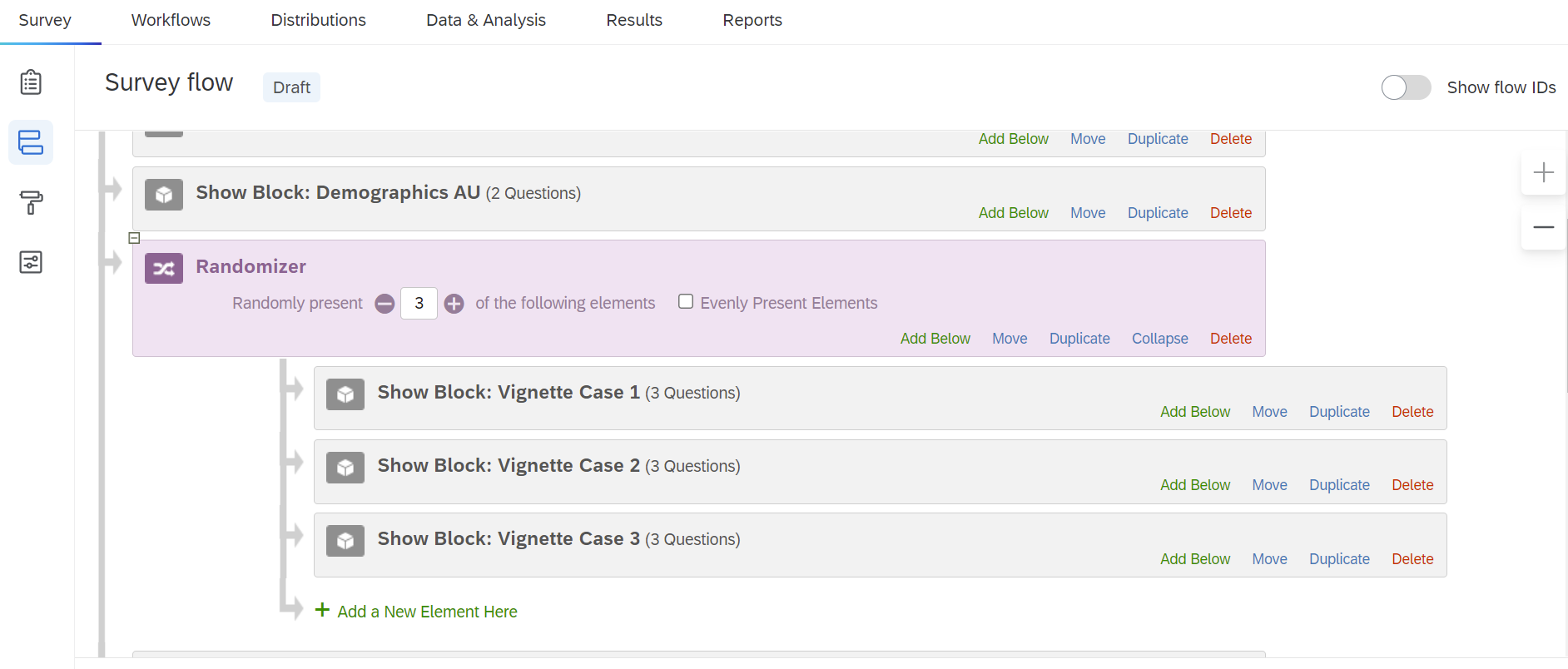 However, I've realised now that ideally I should be controlling for the gender of the protagonist in the vignettes. With this in mind, I'm intending to copy each of the three vignette blocks I currently have and change the gender of the protagonist presented in each vignette. So instead of the three blocks of vignettes I currently have, I will end up with six blocks of vignettes: vignette 1 (male), vignette 1 (female), vignette 2 (male), vignette 2 (female), vignette 3 (male), vignette 3 (female). However, I'm unsure how I can ensure that both of the following randomisations occur: 1) participants will be randomly presented with either the 3 male vignette cases or the 3 female vignette cases, and 2) within that randomisation, the order in which participants are shown the 3 vignettes is randomised. As an example, one participant might complete: vignette 2 (male), vignette 1 (male), then vignette 3 (male), whereas another participant might complete vignette 3 (female), vignette 2 (female), then vignette 1 (female).
However, I've realised now that ideally I should be controlling for the gender of the protagonist in the vignettes. With this in mind, I'm intending to copy each of the three vignette blocks I currently have and change the gender of the protagonist presented in each vignette. So instead of the three blocks of vignettes I currently have, I will end up with six blocks of vignettes: vignette 1 (male), vignette 1 (female), vignette 2 (male), vignette 2 (female), vignette 3 (male), vignette 3 (female). However, I'm unsure how I can ensure that both of the following randomisations occur: 1) participants will be randomly presented with either the 3 male vignette cases or the 3 female vignette cases, and 2) within that randomisation, the order in which participants are shown the 3 vignettes is randomised. As an example, one participant might complete: vignette 2 (male), vignette 1 (male), then vignette 3 (male), whereas another participant might complete vignette 3 (female), vignette 2 (female), then vignette 1 (female).
Hopefully I've communicated this in a way that makes sense. Does anyone know how I can set this up?
Thanks so much!
vx180 Yes, then can be done in the survey flow using a grouping element, branching element, and nested randomizer. I've placed a previous example in the image below. You start first with creating one randomizer. In this randomizer you place two group folders. I've just chosen group 1 and group 2, you could call them male and female if you prefer. Make sure you state the randomizer should only present 1 of those elements and to evenly present them. This will make sure participants see Male or female vignettes, not both. For your data, I would then place and embedded data point within each group. That way you can determine which condition (male/female) the participant went through. Then under the embedded data, place another randomizer and in that randomizer place your three vignettes. Hope this helps! Happy to provide more detail if needed. 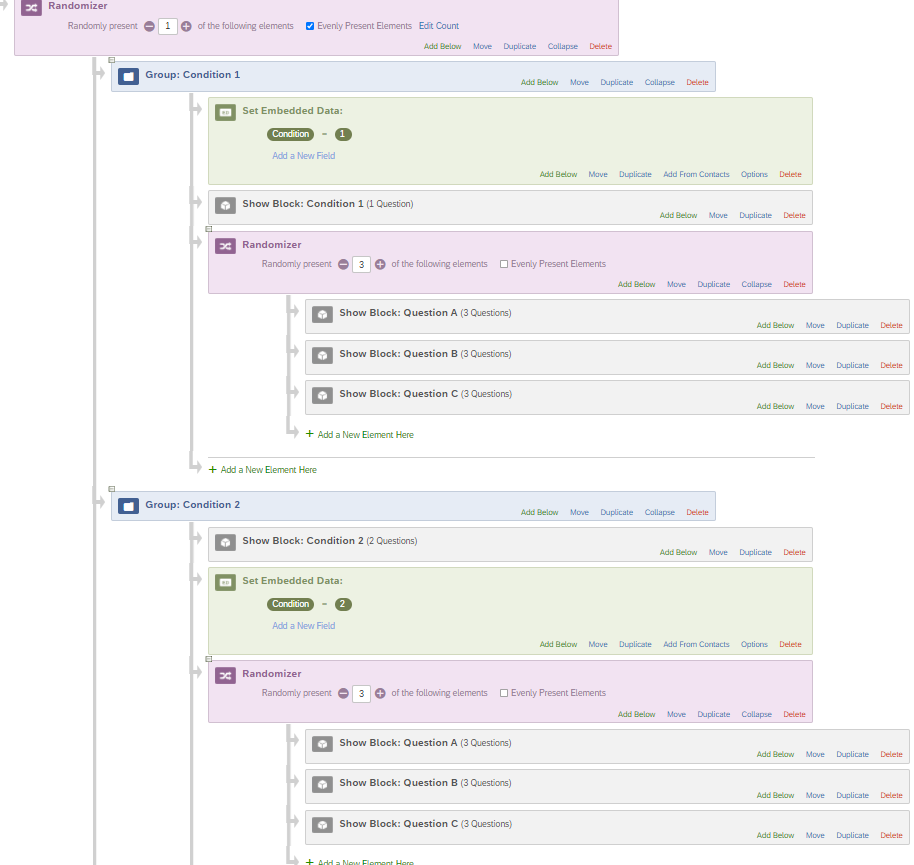
wpm24 Brilliant! Thank you so much for such a clear and thorough explanation!
I've had a go at this with the survey I'm working on and it seems to have done the trick (see the setup in the images below).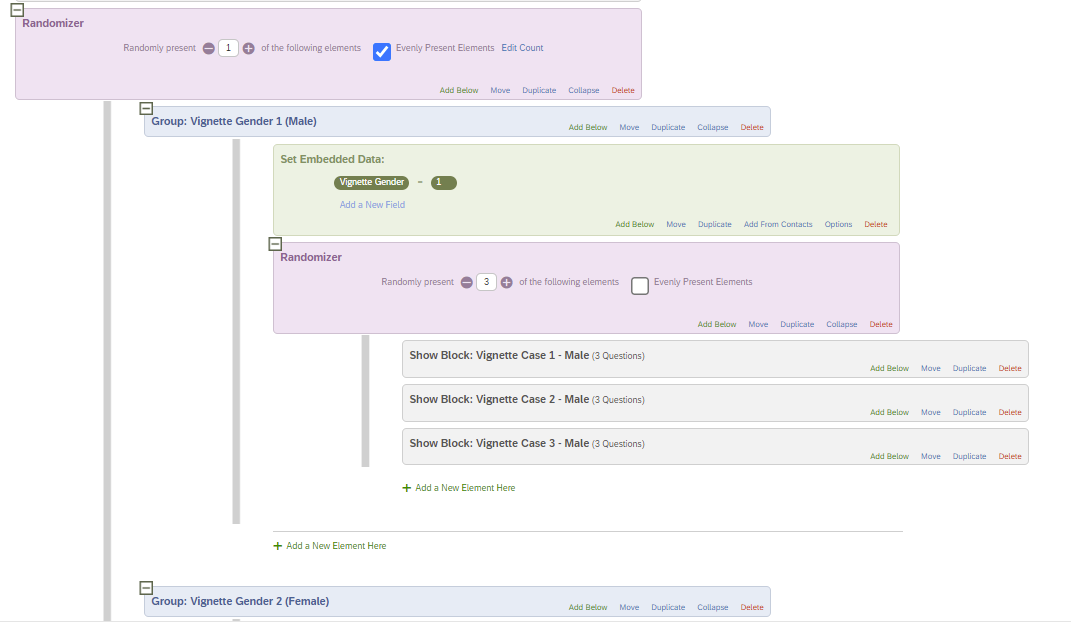
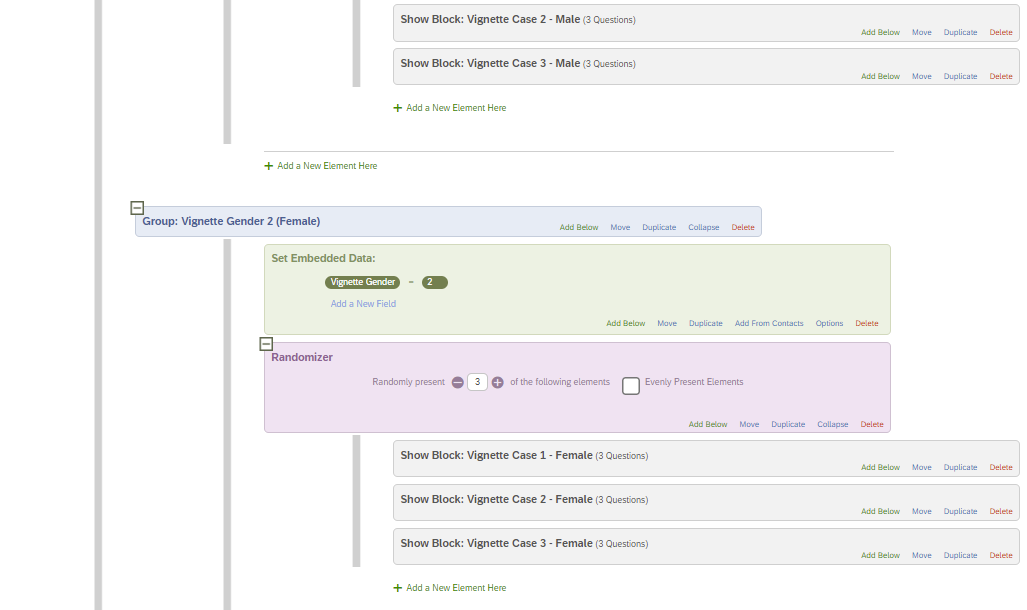 I just had a few extra questions that hopefully you can help me with:
I just had a few extra questions that hopefully you can help me with:
- I've seen on the screenshot you initially posted that there is a block element between the Embedded Data element and the Randomizer labelled "Show Block: Condition 1". I'm wondering whether I'm missing something by not including this in my set up above? For reference, for each of the Vignette Case blocks (e.g., "Vignette Case 1 - Male"), the participant will be shown the case vignette itself on the same page as the three questions that follow within that same block.
- I'm unfamiliar with the 'Set Embedded Data' element. From what I understand, will this simply allow me to look at which of the two sets of vignettes (that is, either the male vignettes or the set of female vignettes) each individual respondent completed when I'm looking at the data? All I did here was label it "vignette gender" when the prompt to enter text came up and then assigned the value 1 for the male vignettes and 2 for the female vignettes. So I imagine when I look at the data I will see each participant assigned a 1 (i.e., male) or a 2 (i.e., female) for this particular question (i.e., vignette gender)?
- Am I right to assume that the "evenly present elements" option is somewhat redundant when I want to display all the blocks within the Randomizer element (as is the case with the three vignette cases)? That is, checking the box or leaving it blank shouldn't make a difference since each respondent will be randomly presented with all three of the vignette case blocks anyway? However, I understand the importance of having "evenly present elements" for the initial randomizer element that sits above the two groups, as this is what ensures that respondents are only shown either the set of three male vignettes or the set of three female vignettes (since I've set this Randomizer to only present 1 of the elements).
Again, thank you so much for your assistance so far, it's been incredibly helpful!
https://community.qualtrics.com/XMcommunity/discussion/comment/46174#Comment_46174vx180
Glad it could help! To respond to your points:
- No, you aren't missing out on anything by not presenting the block between the embedded data set and the randomizer. This was a block that I didn't want randomized in a previous study so it was kept out of the randomizer. Your set up is correct!
- You understand the embedded perfectly and have done it correctly. Just a reference for the future, when you create an embedded data point, it is case sensitive. So if you make a typing mistake in one label (e.g., "Vignette gender" and then "Vignette Gender") you will end up with two different data points in your data. So just make sure they match when you want them to.
- You are also right about the randomizer!
wpm24 Fantastic, thanks again so much for all your help with this! Can't tell you how useful this has been and how much time it has saved me so far!
I hope I'm not abusing the privilege, but I just have one more query about screening out respondents who do not meet the eligibility criteria for the survey. I currently have two "thank and close" messages throughout the survey that will be shown to respondents who will be screened out (an example of one is shown below). In the Survey Builder mode, I have used display logic to only show this message (which sits in its own block) to those who do not meet the criteria, then used skip logic for them to skip to the end of the survey if they click on the 'next' button on the screen (instead of just closing the browser). In the Survey Flow mode, I've also created a branch for those who are shown the "thank and close" screen-out message to then be directed to the End of Survey screen (and used an Embedded Data element to show me which section they screened out of, as there is also another screen out opportunity a bit later). See this below:
In the Survey Flow mode, I've also created a branch for those who are shown the "thank and close" screen-out message to then be directed to the End of Survey screen (and used an Embedded Data element to show me which section they screened out of, as there is also another screen out opportunity a bit later). See this below: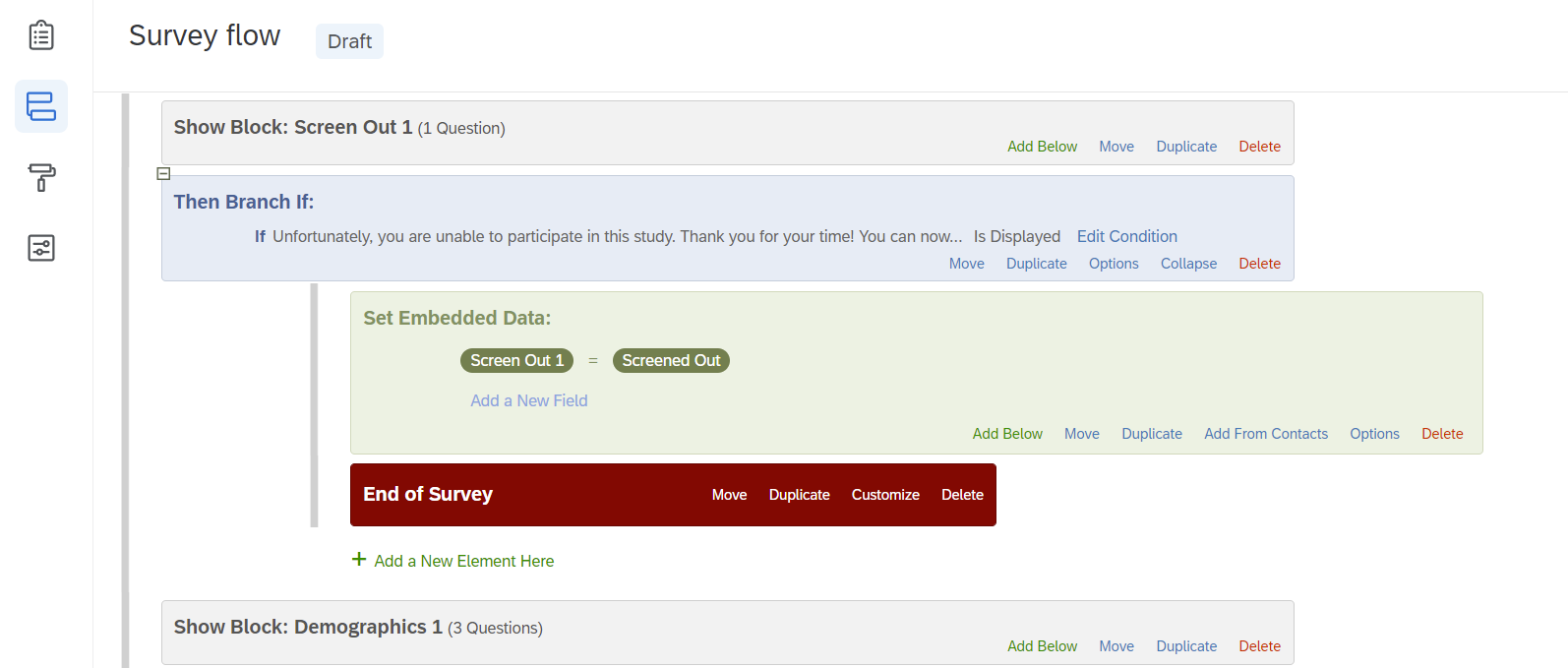 The question I want to ask is whether I've set this up correctly, and whether I've made this unnecessarily complicated by setting things up in both the Survey Builder and Survey Flow modes? And if so, is there one way that works better than the other? I'm also considering showing the screened out participants a different "End of Survey" message than the participants who complete the survey and reach the end (who will be shown a screen thanking them and telling them that their response has been recorded). I suppose I can do this by using the "customize" option under "End of Survey" in the image above, checking the "Override Survey Options" button then selecting "Custom end of survey message"?
The question I want to ask is whether I've set this up correctly, and whether I've made this unnecessarily complicated by setting things up in both the Survey Builder and Survey Flow modes? And if so, is there one way that works better than the other? I'm also considering showing the screened out participants a different "End of Survey" message than the participants who complete the survey and reach the end (who will be shown a screen thanking them and telling them that their response has been recorded). I suppose I can do this by using the "customize" option under "End of Survey" in the image above, checking the "Override Survey Options" button then selecting "Custom end of survey message"?
Thanks again so much! 
https://community.qualtrics.com/XMcommunity/discussion/comment/46200#Comment_46200Not a problem at all!
So yes, you have the right assumption in that you have done the same thing twice. It is sufficient enough to place your branching logic in the survey flow so that if a certain pre-screen option is chosen, they are branched to the end of the survey. You can then customize the message you want to provide in your account and say things like "thank you, but unfortunately you cannot participate for XXX reason, and your survey has ended. Please close your browser". Steps are below.
- So, below, is what you need your survey flow to look like. I've created fake-prescreening questions based on if the participant wants to participate and their age. If they select no to either question, they end the survey. The randomizer at the bottom of the image is the same randomizer I showed you above for the first question.
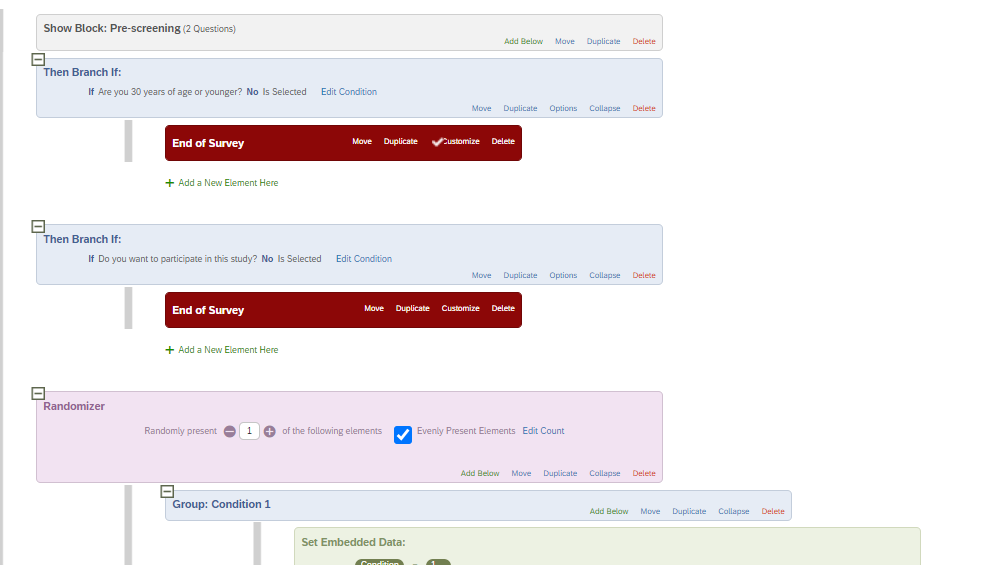 To customize the ending message. First create your custom message in your library (see image below). Make sure this message has a meaningful title. Then, in survey flow, click customize on the survey block you want to customize. Select override message, custom, from the drop down menu select my library, then look for the message you want to display for this block. You can do this for each survey end you have in your flow. Totally up to you.
To customize the ending message. First create your custom message in your library (see image below). Make sure this message has a meaningful title. Then, in survey flow, click customize on the survey block you want to customize. Select override message, custom, from the drop down menu select my library, then look for the message you want to display for this block. You can do this for each survey end you have in your flow. Totally up to you. 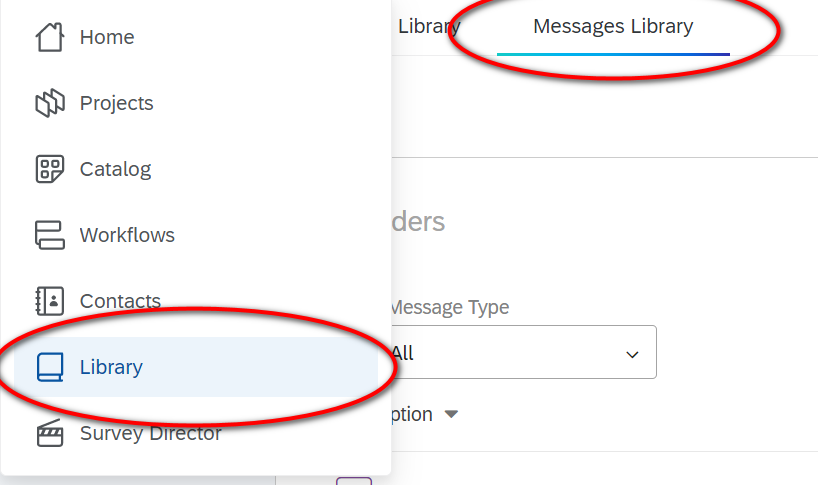
regarding the embedded data, what you have done will be fine and give you a clear data point if their survey ended there and under what conditions. But you can also get this data point based on what choice they made that lead their survey to end. For example, if you have a standard consent form where you as, "do you consent" and they say no, in your data, in the consent variable it will say no (or whatever numerical value you have given it). You can then infer that is why their survey ended. This logic carries to any question. But yes, what you have done is fine! Just up to you if it is needed or not.
Hope this has helped!
Hi again wpm24. Apologies for the late response here, but thanks so much again for your clear and thorough response!
That's good to know! So just to clarify: what I've done so far is essentially doing the same thing twice, but should still work. However, if I wanted to remove the rules I've applied in the Survey Builder mode and just retain the setup in the Survey Flow mode (where I can also now add some customised messages), this should also be fine?
Thanks so much again for your help!
https://community.qualtrics.com/XMcommunity/discussion/comment/46273#Comment_46273Yes exactly, it should work fine even though both aspects are doing the same thing. I would test a couple of times to make sure it doesn't create a weird error (sometimes Qualtrics can do this). But yes you understand perfectly!
Thanks so much for your help and responsiveness! Yes, I think in that case it might be best to remove the rules applied in the Survey Builder mode and simply retain the setup in the Survey Flow mode for the sake of simplicity and the avoidance of any unexpected errors (but making sure to carefully test that everything works correctly still!). Thanks again 
Leave a Reply
Enter your E-mail address. We'll send you an e-mail with instructions to reset your password.
